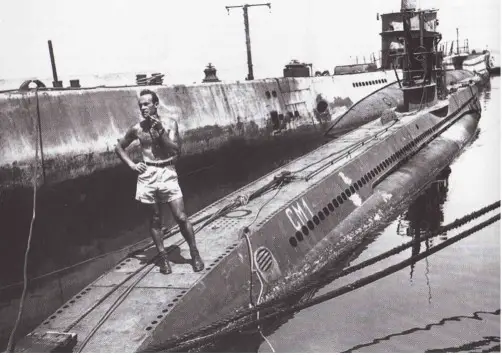The beginning of the end
In November 1942, allied landings in French-controlled North Africa and the Axis defeat at El Alamein put in motion a radical change of the strategic context of the Mediterranean theatre. The overwhelming air and naval forces of the allies could not be countered by the depleted surface forces Regia Marina, busy in keeping the supply routes to Libya and (soon) Tunisia. In this critical situation, the navy leadership was debating on the naval constructions to prioritize, Admiral Legnani (commanding the Italian submarine fleet) pushed for the construction of more submarines of the “Tritone” class, to match the losses and keep up an adequate threat to allied surface forces. Admiral Sansonetti, deputy chief of staff of the Regia Marina and other officers rejected the idea, mainly because there were already several Tritone class units under construction and they did not want to divert workers and resources from the construction of the large R class transport submarines.
The situation in North Africa for the Axis continued to deteriorate in the following months, and the first change in naval construction policy was the order of a new tranche of CB midget submarines, for defensive purposes. Admiral Legnani did not like these small vessels built by the Caproni factory, however, this move was availed by Mussolini, after the insistent requests from Count Caproni for getting new naval constructions for his shipyards.
The troubled life of the CM project
In March 1943, Admiral Raffaele De Courten, a former inspector of the submarine fleet, became “second” deputy chief of staff of the Regia Marina (in aid of Sansonetti). He was also not fully convinced of the military value of the CB class, the small CBs did not have the range, the speed and manoeuvrability to attack in packs the allied surface forces that could have threatened the Italian coasts after the inevitable fall of axis-held Tunisia. In April 1943, the CRDA shipyards came up with a project for a 100t submarine that immediately caught De Courten’s attention. The sub was 32,9 meters long, 2,8 meters large and carried two 450mm torpedoes in two tubes in the bow.
Two experimental units were ordered to CRDA, notwithstanding Legnani’s aversion for midget submarines and the opposition of Caproni towards the project of his rival company.
The new midget submarines built by CRDA were called “C.M.” (Costiero Monfalcone) but soon faced a problem posed by the availability of diesel engines of adequate power and dimension.
The solution came by getting from FIAT some 330 hp engines originally built for the P26/40 tanks. The construction of the new units (CM1 and CM2) continued along the summer of 1943, the fall of Tunisia, the allied invasion of Sicily and the fall of Mussolini (25th July 1943) did not change the Regia Marina’s plan for the CM class. In the meantime, De Courten had become the Navy chief of staff (and also Minister after the fall of Mussolini), he continued to envisage the use of the CM class in small packs (of 6 units) to attack enemy naval forces in the Tyrrhenian and the Ionian Sea.
The armistice and epilogue of the CM units
The CM1 was launched on the 1st September 1943 in Monfalcone (northern Adriatic coast, near Trieste) and started its trials at sea while the CM2 was still under construction.

The CM1 ready for the launch in Monfalcone
The armistice of the 8th of September between Italy and the allies and the events that followed put an end to the whole program. The two units were captured by the Germans and subsequently handed over to the newly born “Republican Navy” of the Italian Social Republic (the fascist puppet state installed by the Germans in the Axis-controlled Italy).
The CM2 was hit in an allied bombing and was never completed while the CM1 became “combat-ready” only in December 1944. The sub never carried out any offensive mission and at the end of the war, its crew surrendered the unit to the allies in Ancona.

The CM1 in navigation in the gulf of Trieste
The solution came by getting from FIAT some 330 hp engines originally built for the P26/40 tanks. The construction of the new units (CM1 and CM2) continued along the summer of 1943, the fall of Tunisia, the allied invasion of Sicily and the fall of Mussolini (25th July 1943) did not change the Regia Marina’s plan for the CM class. In the meantime, De Courten had become the Navy chief of staff (and also Minister after the fall of Mussolini), he continued to envisage the use of the CM class in small packs (of 6 units) to attack enemy naval forces in the Tyrrhenian and the Ionian Sea.

The CM1 at Taranto in 1946
Saving Mussolini?
In 1950, Tullio Tamburini, the former head of Police of the Italian Social Republic, stated that the CM1 had been considered to transport Mussolini and some other fascist leaders to neutral Turkey in case of a final Allied victory. In 1968, another former fascist leader, Antonio Bonino, reported another variant of the plan to save “the Duce”. The CM1 would have crossed the Adriatic and the Ionian Sea to reach in secrecy the coasts of Calabria. Here another submarine would have carried Mussolini to neutral Spain.
Sources
Bagnasco, E., & Brescia, M. (2013). I sommergibili Italiani1940-1943, Parte I – Mediterraneo.
Cernuschi, E. (1998). L’ ultimo sommergibile. STORIA MILITARE n.62, 14-27.